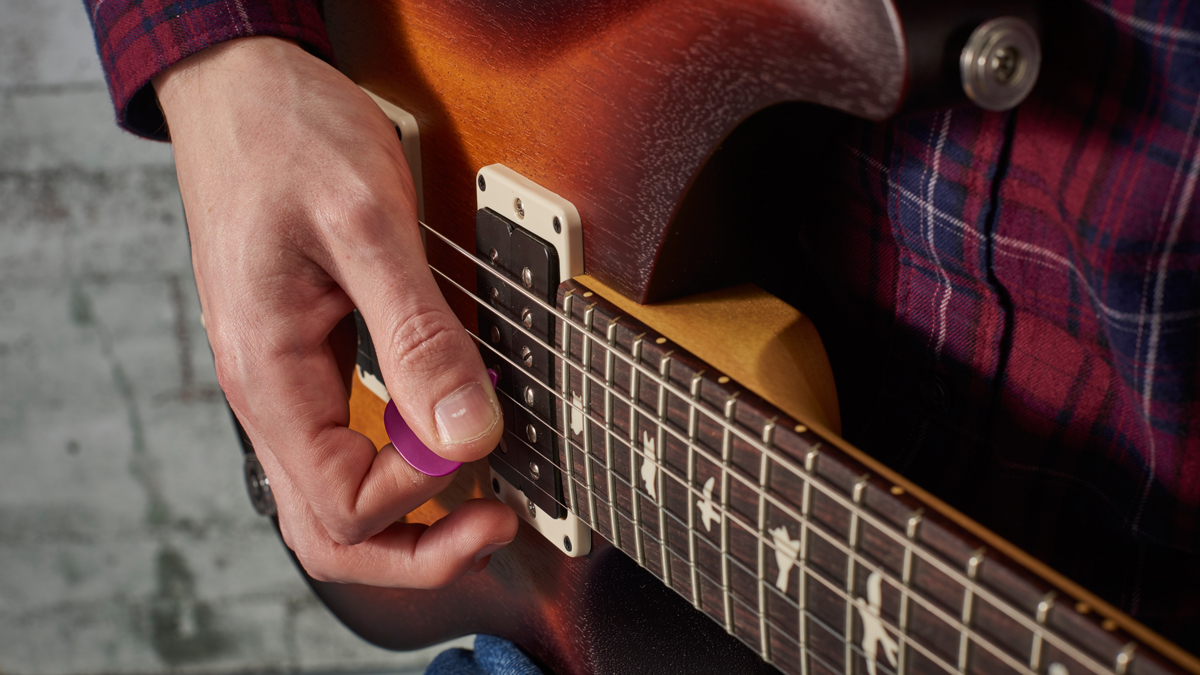How to play a pinch harmonic on guitar
Music is Win's Tyler Larson shares the secret to this essential ingredient in metal guitar playing

I still remember the first time I played a pinch harmonic.
I was 15 years old, rocking out in my basement. I hit the face-melter note at the end of a sloppy pentatonic lick (hey, we all start somewhere) and a pinch harmonic rang out, startling me. It was an accident, of course, and I spent the next hour trying to figure out how to play a pinch harmonic. After trying and failing countless times, I wondered if there had simply been some kind of glitch or electronic anomaly with my amp that had somehow produced a squealing noise where my normal note should have been.
Just when I was about to give up, I found the sound again, and this time, I understood how it was done. Many pinch harmonics were played that day, much to my parents’ chagrin.
The key to executing a pinch harmonic is all in the thumb. You’ll start by holding your pick normally, and then adjust your grip so that your thumb hovers over the pointed end of the pick, becoming an extension of the pick rather than a means for holding it.
Once you have the grip down, you’ll want your thumb to be one with your pick attack, which means your thumb will literally graze the string the microsecond after your pick. With your bridge pickup selected, try a pinch harmonic on a string and fret that is conducive to pinch harmonics – I recommend the fifth fret of the G string.
The last facet of successfully playing a pinch harmonic is to pick the appropriate part of the string. Depending on the note you’re playing, different guitars have different “sweet spots” for pinch harmonics. Typically, picking within an inch of the neck pickup will yield the squeal you’re looking for, but it’s best to experiment with different areas of the string to find the best sound with the least effort.
As you master the technique on one note and look to apply it to other areas of the neck, you’ll find some strings and frets are harder to produce pinch harmonics, so you’ll want to set yourself up for success by cranking up the gain. Pinch harmonics on thicker strings are the most difficult in standard tuning, so if you’re looking for that Zakk Wylde signature sound, you’ll want to tune to Drop D or D flat.
Get The Pick Newsletter
All the latest guitar news, interviews, lessons, reviews, deals and more, direct to your inbox!
Tyler Larson is the founder of the guitar-centric brand Music is Win. His insightful, uncomplicated guitar lessons and gear demonstrations along with entertaining, satirical content about life as a musician receive tens of millions of video views per month across social media. Tyler is also the creator of the extremely popular online guitar learning platform, Guitar Super System. A graduate of Berklee College of Music, Tyler has been teaching guitar for over a decade and operates a production studio in Nashville, TN.
“There are so many sounds to be discovered when you get away from using a pick”: Jared James Nichols shows you how to add “snap, crackle and pop” to your playing with banjo rolls and string snaps
Don't let chord inversions bamboozle you. It's simply the case of shuffling the notes around







![Joe Bonamassa [left] wears a deep blue suit and polka-dotted shirt and plays his green refin Strat; the late Irish blues legend Rory Gallagher [right] screams and inflicts some punishment on his heavily worn number one Stratocaster.](https://cdn.mos.cms.futurecdn.net/cw28h7UBcTVfTLs7p7eiLe.jpg)


